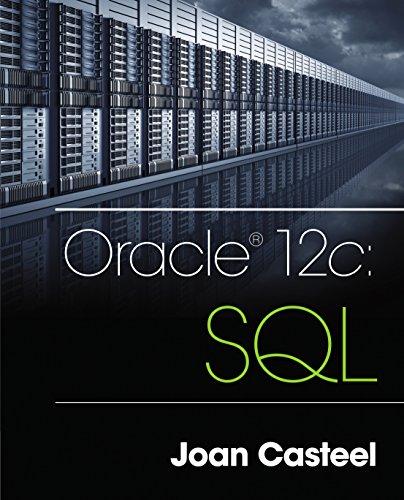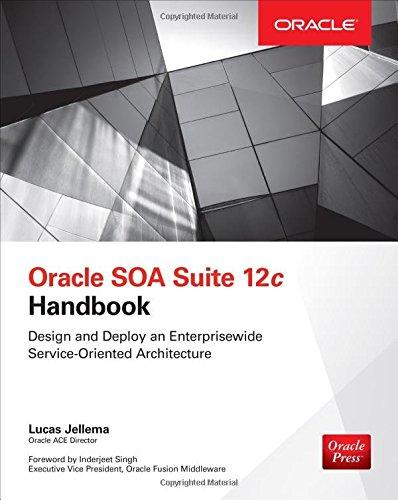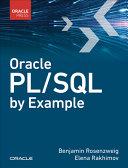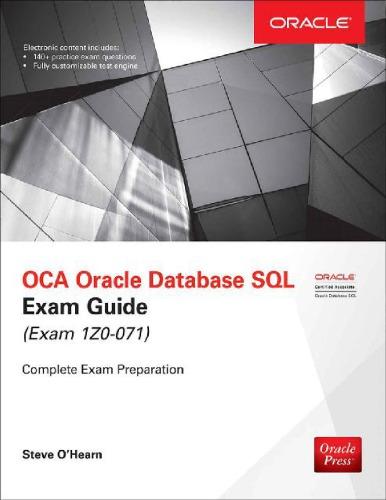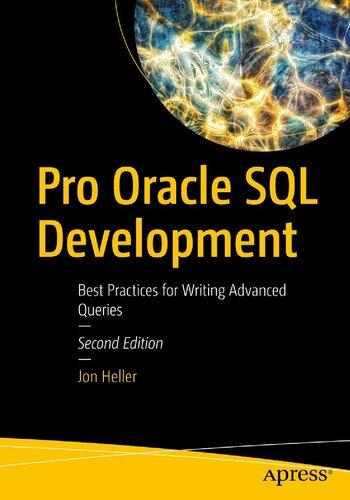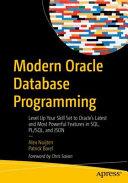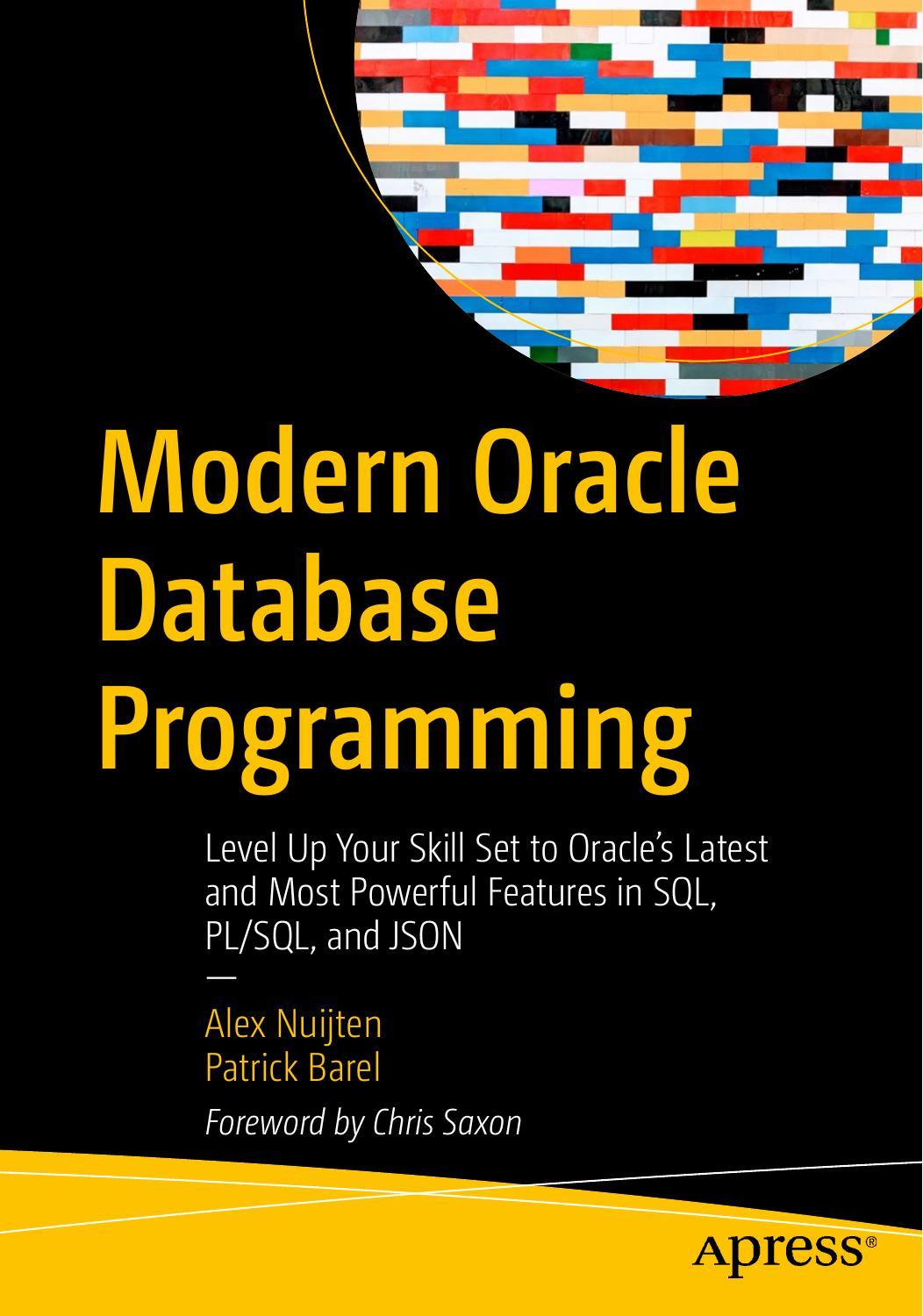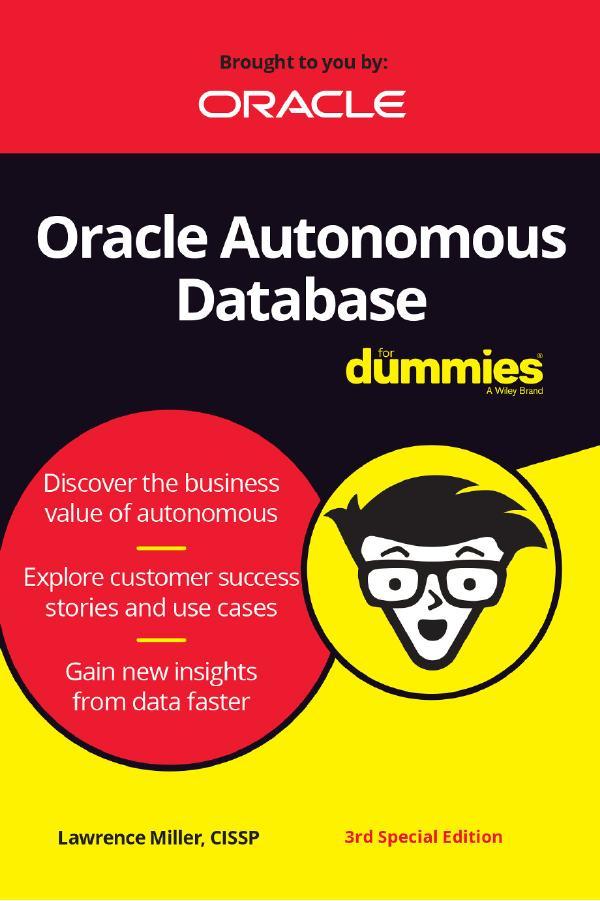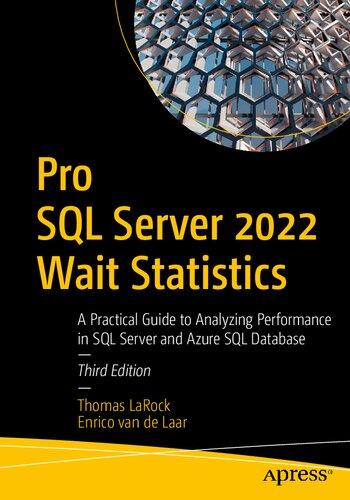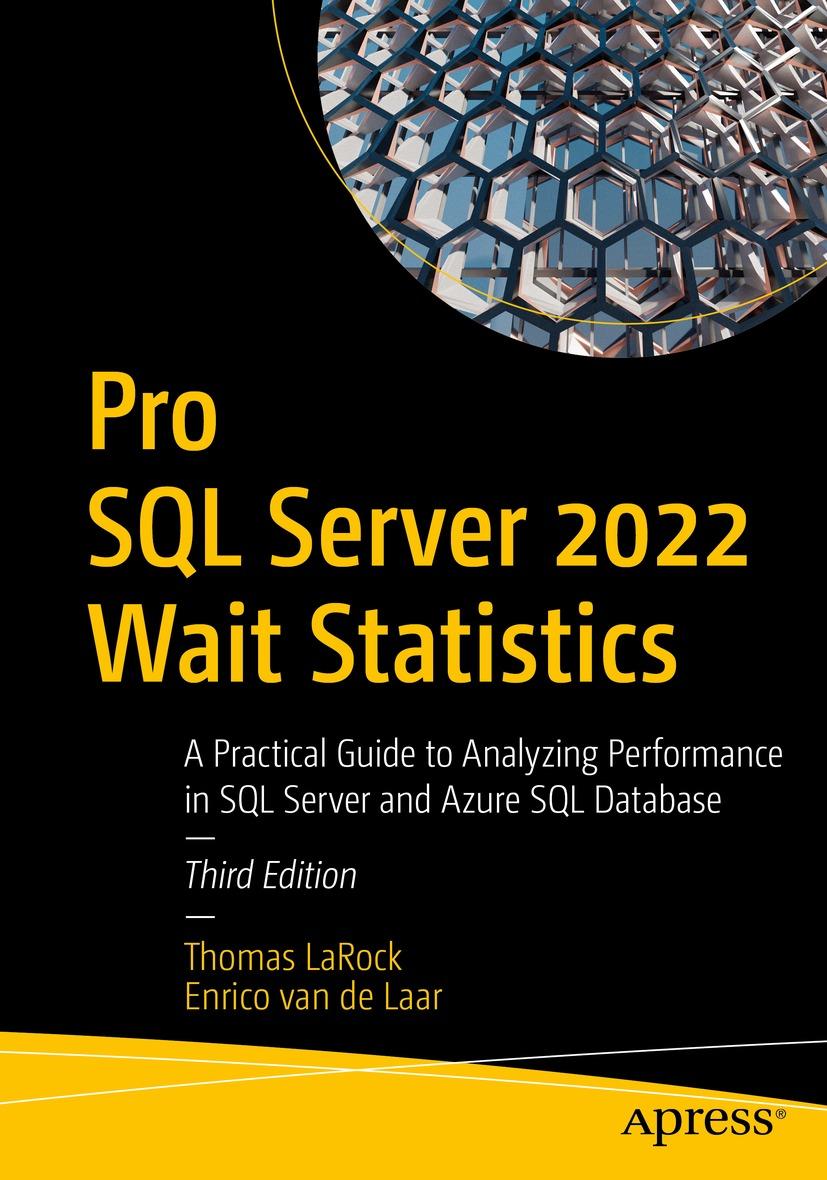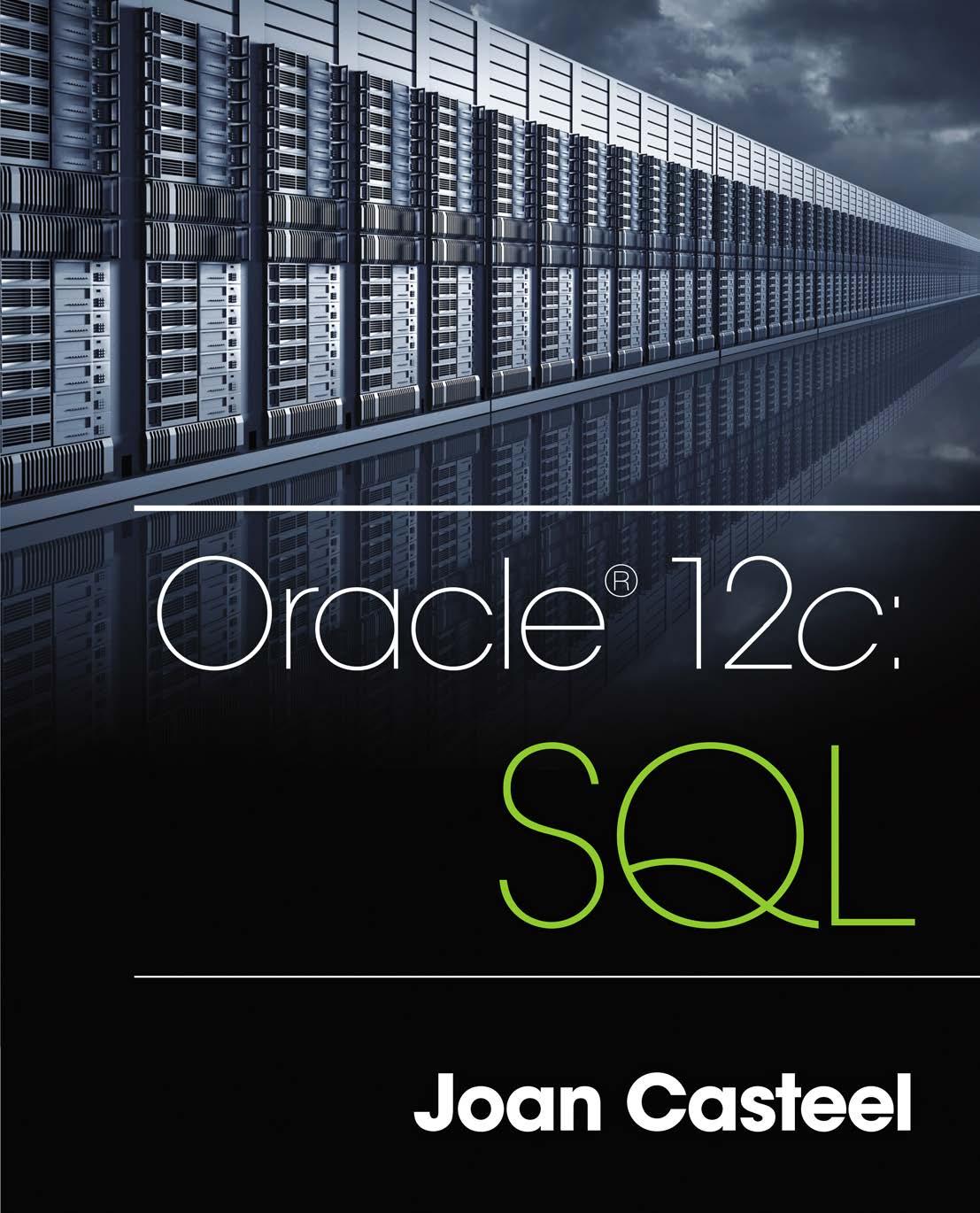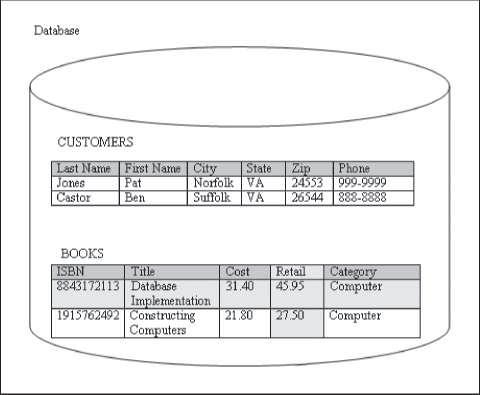Visit to download the full and correct content document: https://ebookmass.com/product/oracle-12c-sql-3rd-edition-ebook-pdf/
More products digital (pdf, epub, mobi) instant download maybe you interests ...
Oracle SOA Suite 12c handbook 1st Edition Jellema
https://ebookmass.com/product/oracle-soa-suite-12c-handbook-1stedition-jellema/
Oracle PL/SQL by Example, 6th Edition Benjamin Rosenzweig
https://ebookmass.com/product/oracle-pl-sql-by-example-6thedition-benjamin-rosenzweig/
OCA Oracle Database SQL Exam Guide (Exam 1Z0-071) 1st Edition Steve O’Hearn
https://ebookmass.com/product/oca-oracle-database-sql-exam-guideexam-1z0-071-1st-edition-steve-ohearn/
Pro Oracle SQL Development: Best Practices for Writing
Advanced Queries 2nd Edition Jon Heller
https://ebookmass.com/product/pro-oracle-sql-development-bestpractices-for-writing-advanced-queries-2nd-edition-jon-heller/
Modern Oracle Database Programming: Level Up Your Skill Set to Oracle’s Latest and Most Powerful Features in SQL, PL/SQL, and JSON 1st Edition Alex Nuijten
https://ebookmass.com/product/modern-oracle-database-programminglevel-up-your-skill-set-to-oracles-latest-and-most-powerfulfeatures-in-sql-pl-sql-and-json-1st-edition-alex-nuijten-2/
Modern Oracle Database Programming: Level Up Your Skill Set to Oracle’s Latest and Most Powerful Features in SQL, PL/SQL, and JSON 1st Edition Alex Nuijten
https://ebookmass.com/product/modern-oracle-database-programminglevel-up-your-skill-set-to-oracles-latest-and-most-powerfulfeatures-in-sql-pl-sql-and-json-1st-edition-alex-nuijten/
Oracle Autonomous Database For Dummies®, 3rd Special Edition Lawrence Miller
https://ebookmass.com/product/oracle-autonomous-database-fordummies-3rd-special-edition-lawrence-miller/
Pro SQL Server 2022 Wait Statistics: A Practical Guide to Analyzing Performance in SQL Server and Azure SQL Database, 3rd Edition Thomas Larock
https://ebookmass.com/product/pro-sql-server-2022-waitstatistics-a-practical-guide-to-analyzing-performance-in-sqlserver-and-azure-sql-database-3rd-edition-thomas-larock/
Pro SQL Server 2022 Wait Statistics: A Practical Guide to Analyzing Performance in SQL Server and Azure SQL Database, 3rd Edition Thomas Larock
https://ebookmass.com/product/pro-sql-server-2022-waitstatistics-a-practical-guide-to-analyzing-performance-in-sqlserver-and-azure-sql-database-3rd-edition-thomas-larock-2/
Thepastfewdecadeshaveseenaproliferationoforganizationsthatrelyheavilyon informationtechnology.Theseorganizationsstoretheirdataindatabases,andmany chooseOracledatabasemanagementsystemstoaccesstheirdata.ThecurrentOracle databaseversion,Oracle12c, isadatabasemanagementsystemthatenablesusersto create,manipulate,andretrievedata.Thepurposeofthistextbookistointroduce studentstobasicSQLcommandsforinteractingwithOracle12c databasesinabusiness environment.Inaddition,conceptsrelatingtoobjectivesofthecurrentOracle certificationexamshavebeenincorporatedforstudentswantingtopursuecertification.
TheIntendedAudience Thistextbookhasbeendesignedforstudentsintechnicaltwo-yearorfour-yearprograms whoneedtolearnhowtointeractwithdatabases.Althoughhavinganunderstandingof databasedesignispreferable,anintroductorychapterhasbeenincludedtoreviewthe basicconceptsofE-Rmodelingandthenormalizationprocess.
OracleCertificationProgram(OCP) ThistextbookcoverstheobjectivesofSQLFundamentalsExamsavailable:1Z0-051for Oracle11g andExam1Z0-061forOracleDatabase12c.MostobjectivesforExam1Z0047,OracleDatabaseSQLExpert,arealsocovered.Anyoftheseexamsserveasthefirst examintheOracleApplicationDevelopmentandOracleDatabaseAdministratorOracle CertifiedAssociatelevelcertificationtracks.Informationaboutregisteringforthese exams,alongwithotherreferencematerial,isavailableat www.oracle.com
TheApproach Theconceptsintroducedinthistextbookarediscussedinthecontextofahypothetical real-worldbusiness:anonlinebookretailernamedJustLeeBooks.Thecompany’ s businessoperationandthedatabasestructureareintroducedandanalyzed,andas commandsareintroducedthroughoutthetextbook,they’remodeledwithexamplesusing theJustLeeBooksdatabase.Usingconsistentexamplesofahypotheticalcompanyhelps youlearnthesyntaxofcommandsandhowtousetheminareal-worldenvironment.In addition,ascriptfilethatgeneratesthedatabaseisavailabletogiveyouhands-onpractice inre-creatingexamplesandpracticingvariationsofSQLcommandstoenhanceyour understanding.
Toexplainwhatadatabaseisandhowit’screated,thistextbookinitiallyfocuses oncreatingtablesandlearninghowtoperformdatamanipulationoperations.After you ’refamiliarwiththedatabasestructure,thefocusthenturnstoqueryingadatabase.
InChapters8through13,youlearnhowtoretrievedatafromthedatabase,usingthe manyoptionsofaSELECTstatement,includingrowfiltering,joins,functions,and subqueries.
Toreinforcethematerial,eachchapterincludesachaptersummaryand,when appropriate,asyntaxguideforthecommandscoveredinthechapter.Inaddition,each chapterincludesreviewquestionsandhands-onactivitiesthattestyourknowledgeand challengeyoutoapplythatknowledgetosolvingbusinessproblems.Arunningcasestudy thatbuildsthroughoutthetextbookprovidesasecondreal-worldsetting acityjail system asanotheropportunitytoworkwithdatabases.
NewtoThisEdition TopicsaddedcoveringnewOracle12c featuresinclude:
• Extendeddatatypes
• Invisiblecolumns
• Defaultcolumnvalues
• SpecifyingavalueforNULLinserts
• Basedonasequencevalue
• Identitycolumns
• Leftouterjoinenhancements
• CROSSAPPLYjoinmethod
• Patternmatchingfortrendanalyses
• EnhancedTop-N-Queryfeatures
In addition,coverageofsubqueryfactoringoruseoftheWITHclausehasbeenadded toChapter12.
OverviewofThisBook Theexamples,assignments,andcasesinthisbookhelpyouachievethefollowing objectives:
• IssueSQLcommandsthatretrievedatabasedoncriteriaspecifiedby the user.
• UseSQLcommandstojointablesandretrievedatafromjoinedtables.
• Performcalculationsbasedondatastoredinthedatabase.
• Usefunctionstomanipulateandaggregatedata.
• Usesubqueriestoretrievedatabasedonunknownconditions.
• Create,modify,anddropdatabasetables.
• Manipulatedatastoredindatabasetables.
• Enforcebusinessrulesbyusingtableconstraints.
• Createusersandassigntheprivilegesusersneedtoperformtasks.
The chapters’ contentsbuildincomplexitywhilereinforcingpreviousideas.Chapter1 introducesbasicdatabasemanagementconcepts,includingdatabasedesign.Chapter2 showshowtoretrievedatafromatable.Chapter3explainshowtocreatenewdatabase tables.Chapter4addressestheuseofconstraintstoenforcebusinessrulesandensurethe integrityoftabledata.Chapter5explainsaddingdatatoatable,modifyingexistingdata, anddeletingdata.Chapter6showshowtouseasequencetogeneratenumbers,create
indexestospeedupdataretrieval,andcreatesynonymstoprovidealiasesfortables. Chapter7stepsyouthroughcreatinguseraccountsandrolesandshowshowtogrant(and revoke)privilegestotheseaccountsandroles.Chapter8explainshowtorestrictrows retrievedfromatable,basedonagivencondition.Chapter9showshowtolinktableswith commoncolumnsbyusingjoins.Chapter10describesthesingle-rowfunctionssupported byOracle12c. Chapter11coverstheusageofmultiple-rowfunctionstoderiveasingle valueforagroupofrowsandexplainshowtorestrictgroupsofrows. Chapter 12covers usingsubqueriestoretrieverowsbasedonanunknownconditionalreadystoredinthe database.Chapter13explainsusingviewstorestrictaccesstodataandreducethe complexityofcertaintypesofqueries.
Theappendixessupportandreinforcechaptermaterials. AppendixA contains printedversionsoftheinitialtablestructureanddatafortheJustLeeBooksdatabaseused throughoutthistextbook. AppendixB introducestheoperationoftheSQL*PlusandSQL Developerclientsoftwaretools. AppendixC listsOracleresourcesforfurtherstudy. AppendixD introducestheSQL*Loaderutilityforimportingdata. AppendixE introduces basicSQLstatementtuningconcepts. AppendixF identifiesSQLdifferencesinsome populardatabases.
Features Toenhanceyourlearningexperience,eachchapterinthistextbookincludesthefollowing elements:
• Chapterobjectives: Each chapterbeginswithalistoftheconceptstobe masteredbythechapter’sconclusion.Thislistgivesyouaquickoverviewof chaptercontentsandservesasausefulstudyaid.
• Runningcase: A sustainedexample,thebusinessoperationofJustLeeBooks, isthebasisforintroducingnewcommandsandpracticingthematerial coveredineachchapter.
• Methodology: As newcommandsareintroducedineachchapter,the commandsyntaxisshownandthenanexample,usingtheJustLeeBooks database,illustratesusingthecommandinthecontextofbusiness operations.Thismethodologyshowsyounotonly how thecommandisused, butalso when and why it’sused.Thescriptfileusedtocreatethedatabaseis availablesothatyoucanworkthroughtheexamplesinthistextbook, engenderingahands-onenvironmentinwhichyoucanreinforceyour knowledgeofchaptermaterial.
• Tip: This feature,designatedbytheTipicon,providespracticaladviceand sometimesexplainshowaconceptappliesintheworkplace.
• Note: These explanations,designatedbytheNoteicon,offermore informationonperformingoperationswithdatabases.
• DatabasePreparation: These notes,placedattheend-of-chapter introductions,tellyouwhichscriptfromthestudentdatafilesyoushould runinpreparationforchapterexamplesandactivities.
• Caution: This warning,designatedbytheCautionicon,pointsoutdatabase operationsthat,ifmisused,couldhavedevastatingresults.
• Chaptersummaries: Each chapter’stextisfollowedbyasummaryofchapter concepts.Thesesummariesareahelpfulrecapofchaptercontents.
xviPreface
• Syntaxsummaries: BeginningwithChapter2,aSyntaxGuidetableis includedaftereachchaptersummarytorecapthecommandsyntaxcovered inthechapter.
• Reviewquestions: End-of-chapter assessmentbeginswithreviewquestions thatreinforcethemainideasintroducedineachchapter.Thesequestions ensurethatyouhavemasteredtheconceptsandunderstandtheinformation coveredinthechapter.
• Multiple-choicequestions: Each chaptercontainsmultiple-choice questionscoveringthematerialinthechapter.Oraclecertification-type questionsareincludedtoprepareyouforthetypeofquestionsyou canexpectoncertificationexamsandmeasureyourlevelof understanding.
• Hands-onassignments: Along withconceptualexplanationsand examples,eachchapterincludeshands-onassignmentsrelatedtothe chapter’scontents.Thepurposeoftheseassignmentsistogiveyou practicalexperience.Inmostcases,theassignmentsarebasedonthe JustLeeBooksdatabaseandbuildontheexamplesinthechapter.
• Advancedchallenge: This sectionposesanotherproblemabouttheJustLee Booksdatabaseforyoutosolveandislargerinscopethanthehands-on assignments.
• Casestudies: At theendofeachchapterisamajorcasestudy,designed tohelpyouapplywhatyouhavelearnedtoreal-worldsituations.These casesgiveyoutheopportunitytosynthesizeandevaluateinformation independently,examinepotentialsolutions,andmakerecommendations, muchasyouwouldinanactualbusinesssituation.Thesecasesusesa databasebasedonacityjailsystem.
SupplementalMaterials Thefollowingsupplementalmaterialsareavailablewhenthisbookisusedinaclassroom setting.Allteachingtoolsavailablewiththisbookareprovidedtoinstructorsonthe CengageLearningWebsiteat www.cengagebrain.com.
• ElectronicInstructor’sManual: TheInstructor’sManualaccompanyingthis textbookincludesthefollowingitems:
• Additionalinstructionalmaterialtoassistinclasspreparation,including suggestions forlecturetopics
• Asamplesyllabus
• Whenapplicable,informationaboutpotentialproblemsthatcanoccurin networked environments
• CengageLearningTestingPoweredbyCogneroisaflexible,onlinesystem that allowsyouto:
• author,edit,andmanagetestbankcontentfrommultipleCengage Learning solutions
• createmultipletestversionsinaninstant
• delivertestsfromyourLMS,yourclassroomorwhereveryouwant
• PowerPointpresentations: Microsoft® PowerPointslidesareincludedfor eachchapter.Instructorscanusetheslidesinthreeways:asteaching aidsduringclassroompresentations,asprintedhandoutsforclassroom distribution,orasnetwork-accessibleresourcesforchapterreview. Instructorscanaddtheirownslidesforadditionaltopicsintroducedto theclass.
• Datafiles: The scriptfilesneededtocreatetheJustLeeBooksandCity JaildatabasesareavailableontheCengageLearningWebsite atwww .cengagebrain.com.
• Solutionfiles: Solutions tochapterexamples,end-of-chapterreview questionsandmultiple-choicequestions,hands-onassignments,andcase studiesareavailableontheCengageLearningWebsiteat www .cengagebrain.com.Thesolutionsarepasswordprotected.
• Figurefiles: Figure filesallowinstructorstocreatetheirownpresentations withfiguresfromthetextbook.
Acknowledgments IfeelfortunatethatCengageLearningpursuedmyauthorshipofthistextbookand continuestosupportmyefforts.Iamoneluckyperson Ihavetwoangelsinheaven,my motherandgrandmother,andoneangelhereonearth,Scott.Withoutthemwatching overme,Iwouldnotbeabletotacklesuchchallenges.Ialsowanttothankmyfather, whoalwaysseemsmoreexcitedthanmeeverytimeIfinishabookproject.
However,thistextbookistheresultofanincredibleeffortbymanypeoplewhom IwishIhadtheopportunitytothankpersonally.First,hatsofftoLoriBradshawand WendyLangerudofS4CarlislePublishingServicesformanagingthecontentforthis projectandkeepingeveryoneonschedule.AndaspecialthankyoutoArulJosephRaj ofLuminaDatamaticsLTDforhisdetailedeffortsinpreparing,reviewing,andformatting thecontent.Thereweremanyothersinvolvedinthisprojectlikeproductmanagement, editing,marketing,andartdevelopment,andeveryeffortwascriticalinmakingthis bookareality.Itrulyappreciatealloftheseefforts.
Inaddition,Ineedtorecognizetheenormouscontributionofcolleaguesand reviewers,whoprovidedhelpfulsuggestionsandinsightintothedevelopmentofthis textbookinearliereditions.And,finally,manythankstotheinstructorswhohave adoptedthistextandhavededicatedtheireffortstoassistotherstolearnthesemost importantdatabaseskills.
xviiiPreface
TOTHEUSER DataFiles Toworkthroughtheexamplesandcompletetheprojectsinthisbook,youneedtoload thedatafilescreatedforthisbook.Yourinstructorwillprovidethesedatafiles,oryou candownloadthemfromtheCengageLearningWebsiteat www.cengagebrain.com and thensearchforthisbook’stitle.Thedatafilesaredesignedtosupplythesamedatashown inchapterexamples,soyoucanhavehands-onpracticeinre-creatingthequeriesand theiroutput.Thetablesinthedatabasecanberesetifyouencounterproblems,suchas accidentallydeletingdata.Workingthroughallexamplesishighlyrecommendedto reinforceyourlearning.
StartingwithChapter2,databasescriptinstructionsaregivenatthebeginningofthe chapter,ifapplicable.Thesedatabasescriptfilesareinthefoldercorrespondingtothe chapter(Chapter5,Chapter10,andsoforth)on www.cengagebrain.com andhave filenamessuchasJLDB_Build_#.sql(substitutingthechapternumberforthe #symbol).Ifthecomputerinyourschoollab oryourowncomputer hasOracle12c installed,youcanworkthroughthechapterexamplesandcompletethehands-on assignmentsandcaseprojects.Manyofthecodingexamplesinthistextbookcanbe completedsuccessfullywithpreviousversionsofOracle(Oracle10g orOracle11g).
ConnectingtoOracle MostcollegeswillprovidevariousoptionsforaccessingOraclesoftwaretoexecuteSQL statementsrequiredinthistext,typicallyviatheinternetand/orusingcollegecomputer labs.Contactyourinstructorfirsttoidentifytheoptionsavailable.Ifyouchoosetoinstall Oracle12c onyourowncomputer,visit www.oracle.com andgotothedatabase downloadarea.Thedatabasesoftwareisfreelyavailableforlearningpurposes,however,it isveryimportantthatyouviewthedocumentationforthesoftwarepriortodownloading andinstallingthesoftware.Besuretoreviewthehardwareandsoftwarerequirements priortoattemptingtheinstall.YouwillbeaskedtosetupafreeOracleTechnology Networkaccountbeforedownloading.IfyouarenewtoOracle,consultwithyour instructorpriortoinstallingOracledatabasesoftwareforguidance.Thistextwastested onOracleDatabase12c release12.1.0.1.0.
WhenyouinstalltheOraclesoftware,you’repromptedtochangethepasswordfor certaindefaultadministrativeuseraccounts.Makesureyourecordtheaccounts’ names andpasswordsbecauseyoumightneedtologintothedatabasewithoneofthese administrativeaccountsinlaterchapters.AfteryouinstallOracle,you’rerequiredto
enterausernameandpasswordtoaccessthesoftware.Onedefaultusernamecreated duringinstallationis “scott.”
Also,notethatyoucan’tuseyourowncomputertoworkthroughchapterexamples andcompleteprojectsunlessyouhavethedatafiles.Youcangetthesefilesfromyour instructor,oryoucandownloadthemfromtheCengageLearningWebsiteat www .cengagebrain.com andthensearchforthisbook’stitle.Whenyoudownloadthedata files,theyshouldbestoredinadirectoryseparatefromanyotherfilesonyourharddrive. Youneedtorememberthepathorfoldercontainingthesefilesbecauseeachscript filenamemustbeprefixedwithitslocationbeforeyourunthescript.
VisitOurWebSite Asupplementalchapteronformattingreportoutputhasbeenincludedinthebook’ s onlinematerials.Additionalmaterialsdesignedespeciallyforthistextbookmightbe availableontheCengageLearningWebsite.Goto www.cengagebrain.com periodically andsearchthissiteformoredetails.
TOINSTRUCTORS Tocompleteexamplesandactivitiesinthistextbook,yourstudentsmusthaveaccessto thedatafilesincludedontheInstructorResourcesGD(ordownloadedfrom www .cengagebrain.com).
ThedatafilesconsistoftheJustLeeDatabasefolderandafolderforeachchapter. Manychaptersrequirerunningascript;ifso,theseinstructionsaregiveninanoteatthe beginningofthechapter.Thesescriptsareinfolderscorrespondingtothechapter (Chapter5,Chapter10,andsoforth)andhavefilenamessuchasJLDB_Build_#.sql (substitutingthechapternumberforthe#symbol).Theinitialdatabasecreationisdone atthebeginningofChapter2tocreatetheJustLeeBooksdatabase.Studentsshouldrun thescriptsasinstructedtohaveacopyofthetablesstoredintheirschemas.Youshould instructyourstudentsonhowtoaccessandcopydatafilestotheirowncomputers.The chaptersandprojectsinthisbookweretestedwithOracle12c StandardEdition.
CengageLearningDataFiles Youaregrantedalicensetocopydatafilestoanycomputerorcomputernetworkusedby peoplewhohavepurchasedthisbook.
CHAPTER 1 OVERVIEWOFDATABASE CONCEPTS LEARNINGOBJECTIVES Aftercompletingthischapter,youwillbeabletodothefollowing:
• Definedatabaseterms
• Identifythepurposeofadatabasemanagementsystem(DBMS)
• Explaindatabasedesignbyusingentity-relationshipmodelsand normalization
• ExplainthepurposeofaStructuredQueryLanguage(SQL)
• Understandhowthistextbook’stopicsaresequencedandhowthetwo sampledatabasesareused
• Identifythesoftwareusedinthistextbook
INTRODUCTION Imagineyou’restartingupanonlinebookretailcompany.Howwillcustomerorders berecorded?Willcustomersbeabletosearchforproductsbynameorkeywords?Willyou beabletoanalyzesalesinformationtotrackprofits,determineproductsuccess,andtarget marketingeffortstocustomers?Analyzingthousandsoforderscouldtakedayswithout usingadatabase.A database simplifiesthesetasksbecauseit’sastoragestructurethat providesmechanismsforrecording,manipulating,andretrievingdata.
Thedatabaseusedthroughoutthistextbookisbasedontheactivitiesofa hypotheticalbusiness,anonlinebooksellernamedJustLeeBooks.Thecompanysells booksviatheInternettocustomersthroughouttheUnitedStates.Whenanewcustomer placesanorder,heorsheprovidesdatasuchasname,billingandshippingaddresses,and itemsordered.Thecompanyalsousesadatabaseforallbooksininventory.
ToaccessthedatarequiredforoperatingJustLeeBooks,managementreliesona DBMS.A databasemanagementsystem(DBMS) isusedtocreateandmaintainthe structureofadatabase,andthentoenter,manipulate,andretrievethedataitstores. Creatinganefficientdatabasedesignisthekeytousingadatabaseeffectivelytosupport anorganization’sbusinessoperations.
Thischapterintroducesbasicdatabaseterminologyanddiscussestheprocessof designingadatabaseforJustLeeBooks.
DATABASETERMINOLOGY Wheneveracustomeropensanaccountwithacompany,certaindatamustbecollected. Inmanycases,thecustomercompletesanonlineformthatasksforthecustomer’ sname, address,andsoon,asshowninFigure1-1.
FIGURE1-1 Collectingcustomerinformation
Whilecollectingcustomerinformation,aseriesofcharactersisidentifiedforeachitem. A character isthebasicunitofdata,anditcanbealetter,number,orspecialsymbol.
Agroupofrelatedcharacters(forexample,thecharactersthatmakeupacustomer’ s name)iscalleda field.Afieldrepresentsoneattributeorcharacteristic(thename,for instance)ofthecustomer.Acollectionoffieldsaboutonecustomer(forexample,name, address,city,state,andzipcode)iscalleda record.Agroupofrecordsaboutthesame typeofentity(suchascustomersorinventoryitems)isstoredina file.Acollectionof interrelatedfiles suchasthoserelatingtocustomers,theirpurchases,andtheir payments isstoredinadatabase.
Thesetermsrelatetothelogicaldatabasedesign,buttheyareoftenused interchangeablywiththeterminologyforthephysicaldatabasedesign.Whencreatingthe physicaldatabase,afieldiscommonlyreferredtoasa column,arecordiscalleda row, andafileisknownasa table.Atableisquitesimilartoaspreadsheet,inthatitcontains columnsandrows.Figure1-2showsarepresentationoftheseterms.
DATABASEMANAGEMENTSYSTEM Asmentionedearlier,adatabaseishousedinaDBMS,whichprovidesthefunctionalityto createandworkwithadatabase.Thisfunctionalityincludesthefollowing:
• Datastorage: Managethephysicalstructureofthedatabase.
• Security: Controluseraccessandprivileges.
• Multiuseraccess: Manageconcurrentdataaccess.
• Backup: Enablerecoveryoptionsfordatabasefailures.
• Dataaccesslanguage: Providealanguagethatallowsdatabaseaccess.
• Dataintegrity: Enableconstraintsorchecksondata.
• Datadictionary: Maintaininformationaboutdatabasestructure.
FIGURE1-2 Databaseterminology
DATABASEDESIGN Todeterminethemostappropriatestructureoffields,records,andfilesinadatabase, developersgothroughadesignprocess.Thedesignanddevelopmentofasystemis accomplishedthroughaprocessthat’sformallycalledthe SystemsDevelopmentLife Cycle(SDLC) andconsistsofthefollowingsteps:
1. Systemsinvestigation: Understandingtheproblem
2. Systemsanalysis: Understandingthesolutiontothepreviouslyidentified problem
3. Systemsdesign: Definingthelogicalandphysicalcomponents
4. Systemsimplementation: Creatingthesystem
5. Systemsintegrationandtesting: Placingthesystemintooperationfortesting
6. Systemsdeployment: Placingthesystemintoproduction
7. Systemsmaintenanceandreview: Evaluatingtheimplementedsystem
AlthoughtheSDLCisamethodologydesignedforanytypeofsystemanorganization needs,thischapterspecificallyaddressesdevelopingaDBMS.Forthepurposesofthis discussion,assumetheproblemidentifiedistheneedtocollectandmaintaindataabout customersandtheirorders.Theidentifiedsolutionistouseadatabasetostoreallneeded data.Thediscussionthatfollowspresentsthestepsfordesigningthedatabase.
NOTE AvarietyofSDLCmodelshavebeendevelopedtoaddressdifferentdevelopmentenvironments.The stepspresentedhererepresentatraditionalwaterfallmodel.Othermodels,suchasfountainandrapid prototyping,involveadifferentseriesofsteps.
Todesignadatabase,therequirementsofthedatabase inputs,processes,and outputs mustbeidentifiedfirst.Usually,thefirstquestionaskedis, “Whatinformation,or output,mustcomefromthisdatabase?” or “Whatquestionsshouldthisdatabasebeableto answer?” Byunderstandingthenecessaryoutput,thedesignercanthendeterminewhat informationshouldbestoredinthedatabase.Forexample,iftheorganizationwantsto sendbirthdaycardstoitscustomers,thedatabasemuststoreeachcustomer’sbirthdate. Aftertherequirementsofadatabasehavebeenidentified,anentity-relationship(E-R) modelisusuallydraftedtobetterunderstandthedatatobestoredinthedatabase.InanE-R model,an entity isanyperson,place,orthingwithcharacteristicsorattributesthatwillbe includedinthesystem.An E-Rmodel isadiagramthatidentifiestheentities(customers, books,orders,andsuch)inthedatabase,anditshowshowtheentitiesarerelatedtoone another.Itservesasthelogicalrepresentationofthephysicalsystemtobebuilt.
ThenexttwosectionsexplaintheconstructionofanE-Rmodelandthe normalizationprocessusedtodetermineappropriateentitiesforadatabase.
Entity-Relationship(E-R)Model InanE-Rmodel,anentityisusuallyrepresentedasasquareorrectangle.Asshownin Figure1-3,alinedepictshowanentity’sdatarelatestoanotherentity.Iftheline connectingtwoentitiesissolid,therelationshipbetweentheentitiesismandatory. However,iftherelationshipbetweentwoentitiesisoptional,adashedlineisused.
AsshowninFigure1-3,thefollowingtypesofrelationshipscanexistbetweentwo entities:
• One-to-one: Inaone-to-onerelationship,eachoccurrenceofdatainone entityisrepresentedbyonlyoneoccurrenceofdataintheotherentity. Forexample,ifeachclassroomisassignedtoonlyoneacademicdivision,a one-to-onerelationshipiscreatedbetweentheclassroomanddivision entities.ThistypeofrelationshipisdepictedinanE-Rmodelasasimple straightline.
• One-to-many: Inaone-to-manyrelationship,eachoccurrenceofdatainone entitycanberepresentedbymanyoccurrencesofthedataintheother entity.Forexample,aclasshasonlyoneinstructor,butaninstructormight teachmanyclasses.Aone-to-manyrelationshipisrepresentedbyastraight linewithacrow’sfootatthe “ many ” end.
• Many-to-many: Inamany-to-manyrelationship,datacanhavemultiple occurrencesinbothentities.Forexample,aclasscanconsistofmorethan onestudent,andastudentcantakemorethanoneclass.Astraightlinewith acrow ’sfootateachendindicatesamany-to-manyrelationship.
Figure1-4showsasimplifiedE-RmodelfortheJustLeeBooksdatabaseused throughoutthistextbook.AmorethoroughE-Rmodelwouldincludealistofattributesfor eachentity.
NOTE ThenotationsinthesampleE-Rmodelsinthischapterreflectonlyonewayofdiagrammingentity relationships.Ifyou’reusingamodelingsoftwaretool,youmightencounterdifferentnotationsto representrelationships.Forexample,Microsoftproductstypicallyrepresentthemanysideofa relationshipwiththeinfinitysymbol(∞).Inaddition,somemodelingtoolsautomaticallyaddthecommon fieldsorforeignkeycolumnsneededasrelationshipsaredefined.
FIGURE1-3 E-Rmodelnotationexamples
ThefollowingrelationshipsaredefinedintheE-RmodelinFigure1-4:
• Customerscanplacemultipleorders,buteachordercanbeplacedbyonlyone customer(one-to-many).ThedashedlinebetweenCustomersandOrders meansacustomercanexistinthedatabasewithouthavingacurrentorder storedintheORDERStable.Therefore,thisrelationshipisconsideredoptional.
• Anordercanconsistofmorethanonebook,andabookcanappearonmore than oneorder(many-to-many).
• Abookcanhavemorethanoneauthor,andanauthorcanwritemorethan one book(many-to-many).
• Abookcanhaveonlyonepublisher,butapublishercanpublishmorethan one book(one-to-many).
AlthoughsomeE-Rmodelingapproachesaremorecomplex,thesimplifiednotations usedinthischapterdopointouttheimportantrelationshipsamongentities,andusing themhelpsdesignersidentifypotentialproblemsintablelayouts.AfterexaminingtheE-R modelinFigure1-4,youshouldhavenoticedthetwomany-to-manyrelationships.Before creatingthedatabase,allmany-to-manyrelationshipsmustbereducedtoasetofoneto-manyrelationships,asyoulearnin “RelatingTablesintheDatabase” laterinthis chapter.
Identifyingentitiesandrelationshipsinthedatabasedesignprocessisimportant becauseentitiesareusuallyrepresentedasatable,andrelationshipscanrevealwhether additionaltablesareneededinthedatabase.Iftheproblemarisingfromthemanyto-manyrelationshipintheE-Rmodelisn’tapparenttoadesigneratthispoint,itwill becomeclearduringthenormalizationprocess.
DatabaseNormalization Manypeopleunfamiliarwithdatabasedesignprinciplesoftenask, “Whynotjustputallthe datainonebigtable?” Thissingle-tableapproachleadstoproblemsofdataredundancy (duplication)anddataanomalies(datainconsistencies).Forexample,reviewtheorderdata recordedinTable1-1.Thecustomerinformationisrepeatedforeachorderacustomer places(redundancy).Also,thecitydatainthelastrowisdifferentfromthefirsttworows. Underthesecircumstances,itisn’tclearwhetherthelastrowactuallyrepresentsadifferent
customer,whetherthepreviouscustomerhadanaddresschange,orwhetherthecity informationisincorrect(dataanomaly).
TABLE1-1 Single-TableApproachExample Toavoidthesedataissues,database normalization isusedtocreateadesignthat reducesoreliminatesdataredundancyand,therefore,avoidsdataanomalies.Ingeneral, normalizationhelpsdatabasedesignersdeterminewhichattributes,orfields,belongto eachentity.Inturn,thisinformationhelpsdeterminewhichfieldsbelongineachtable. Normalizationisamultistageprocessthatenablesdesignerstotaketherawdatatobe collectedaboutanentityanddevelopthedataintoastructured,normalizedformthat reducestherisksassociatedwithdataredundancy.Dataredundancyposesaspecial problemindatabasesbecausestoringthesamedataindifferentplacescancauseproblems whenupdatesorchangestodataarerequired.
Mostnoviceshavedifficultyunderstandingtheimpactofstoring unnormalized data datathathasn’tbeendesignedbyusinganormalizationprocess.Here’sanexample. Supposeyouworkforalargecompanyandsubmitachange-of-addressformtotheHuman Resources(HR)Department.IfallthedataHRstoresisnormalized,adataentryclerkneeds toupdateonlytheEMPLOYEESmastertablewithyournewaddress.
However,ifthedatais not storedinanormalizedformat,thedataentryclerklikely needstoenterthechangeineachtablecontainingyouraddress theEMPLOYEE RECORDtable,theHEALTHINSURANCEtable,theSICKLEAVEtable,theANNUALTAX INFORMATIONtable,andsoon eventhoughallthisdataisstoredinthesamedatabase. Asaresult,ifyourmailingaddressisstoredinseveraltables(orevenduplicatedinthe sametable)andthedataentryclerkfailstomakethechangeinonetable,youmightgeta paycheckshowingoneaddressand,attheendoftheyear,haveyourW-2formmailedtoa differentaddress!Storingdatainanormalizedformatmeansonlyoneupdateisrequired toreflectthenewaddress,anditshouldalwaysbetheonethatappearswheneveryour mailingaddressisneeded.
AportionofthedatabaseforJustLeeBooks isusedinthissectiontostepthroughthe normalizationprocess specifically,thebookssoldtocustomers.Foreachbook,youneedto storeitsInternationalStandardBookNumber(ISBN),title,publicationdate,wholesalecost, retailprice,category(literature,self-help,andsoforth),publishername,contactpersonatthe publisherforreorderingthebook(andtelephonenumber),andauthororauthors’ names.
Table1-2showsasampleofthedatathatmustbemaintained.Foreaseofillustration, thepublishers’ telephonenumbersareeliminated,andtheauthors’ namesusejustthe firstinitialandlastname.Thefirststepindeterminingwhichdatashouldbestoredin eachtableisidentifyinga primarykey,whichisafieldthatidentifieseachrecord
uniquely.YoumightselecttheISBNtoidentifyeachbookbecausenotwobookseverhave thesameISBN.
NOTE Whendatathatalreadyexists,suchasabookISBN,isusedasaprimarykey,it’softenreferredtoas anintelligentkeyoranaturalkey.Attimes,dataservingasaprimarykeydoesn’texist,soasystemgenerateduniquevalueisusedasaprimarykey.Forexample,JustLeeBooksdoesn’thaveanIDto associatewithbookauthors,soanIDnumberisgenerated.Thistypeofdataisreferredtoasa surrogatekeyoranartificialkey.
However,notethatinTable1-2,ifabookhasmorethanoneauthor,theAuthorfield containsmorethanonedatavalue.Whenarecordcontainsrepeatinggroups(thatis, multipleentriesforasinglecolumn),it’sconsideredunnormalized. First-normalform (1NF) indicatesthatallvaluesofthecolumnsareatomic meaningtheycontainno repeatingvalues.Toconvertrecordsto1NF,removetherepeatingvaluesbymakingeach authorentryaseparaterecord,asshowninTable1-3.
InTable1-3,therepeatingvaluesofauthors’ namesareeliminated eachrecordnow containsnomorethanonedatavaluefortheAuthorfield.Noticethatyoucannolonger usethebook’sISBNastheprimarykeybecausemorethanonerecordnowhasthesame valueintheISBNfield. Theonlycombinationoffieldsthatidentifieseachrecord uniquelyistheISBNandAuthorfieldstogether. Whenmorethanonefieldisusedasthe primarykeyforatable,thecombinationoffieldsisusuallyreferredtoasa composite primarykey.Nowthattherepeatingvalueshavebeeneliminatedandtherecordscanbe identifieduniquely,thedataisin1NF,butafewdesignproblemsremain.
Aproblemknownaspartialdependencycanoccurwhentheprimarykeyconsistsof morethanonefield. Partialdependency meansthefieldscontainedinarecord(row) dependononlyoneportionoftheprimarykey.Forexample,abook’stitle,publicationdate, publishername,andsoon,alldependonthebookitself,notonwhowrotethebook(the author). Thesimplestwaytoresolveapartialdependencyistobreakthecomposite primarykeyintotwoparts eachrepresentingaseparatetable. Inthiscase,youcan createatableforbooksandatableforauthors.Byremovingthepartialdependency,you haveconvertedtheBOOKStableto second-normalform(2NF),asshowninTable1-4.
NowthattheBOOKSrecordsarein2NF,youmustlookforanytransitivedependencies. A transitivedependency meansatleastonevalueintherecordisn’tdependentonthe primarykeybutonanotherfieldintherecord.Inthiscase,thecontactpersonfromthe publisher’sofficeisactuallydependentonthepublisher,notonthebook.Toremovethe transitivedependencyfromtheBOOKStable,removethecontactinformationandplaceitin aseparatetable.Becausethetablewasin2NFandhadalltransitivedependenciesremoved, theBOOKStableisnowin third-normalform(3NF),asshowninTable1-5.
TABLE1-5 TheBOOKSTablein3NF
Thereareseverallevelsofnormalizationbeyond3NF;however,inpractice,tablesare typicallynormalizedonlyto3NF.Thefollowinglistsummarizesthenormalizationsteps explainedinthissection:
1. 1NF: Eliminateallrepeatingvaluesandidentifyaprimarykeyorprimary compositekey.
2. 2NF: Makecertainthetableisin1NFandeliminateanypartialdependencies.
3. 3NF: Makecertainthetableisin2NFandremoveanytransitive dependencies.
RelatingTablesintheDatabase AftertheBOOKStableisin3NF,youcanthennormalizeeachremainingtableofthe database.Aftereachtablehasbeennormalized,makecertainallrelationshipsamongtables havebeenestablished.Forexample,youneedawaytodeterminetheauthor(s)foreach bookintheBOOKStable.Becauseauthors’ namesarestoredinaseparatetable,theremust besomewaytojoindata.Usually,aconnectionbetweentwotablesisestablishedthrougha commonfield oneexistinginbothtables.Inmanycases,thecommonfieldisaprimary keyforoneofthetables.Inthesecondtable,it’sreferredtoasaforeignkey.Thepurposeof a foreignkey istoestablisharelationshipwithanothertableortables.Theforeignkey appearsinthe “ many ” sideofaone-to-manyrelationship.
AnacceptedindustrystandardistouseanIDcode(numbersand/orletters)to representanentity;thiscodereducesthechancesofdataentryerrors.Forexample,instead ofenteringeachpublisher’sentirenameintheBOOKStable,youassigneachpublisheran IDcodeinthePUBLISHERtable,andthenlistthatIDcodeintheBOOKStableasaforeign keytoretrievethepublisher’snameforeachbook.Inthiscase,thepublisherIDcodecould betheprimarykeyinthePUBLISHERtableandaforeignkeyintheBOOKStable.
DuringthenormalizationofJustLeeBooks’ database,themany-to-manyrelationships preventnormalizingauthorandorderdatato3NF.Theunnormalizedversionofthedata hasrepeatinggroupsforauthorsintheBOOKStableandforbooksintheORDERStable. Aspartofconvertingthedatainto3NF,twoadditionaltablesmustbecreated: ORDERITEMSandBOOKAUTHOR.
Amany-to-manyrelationshipcan’texistinarelationaldatabase. Themostcommon approachtoeliminatingamany-to-manyrelationshipistocreatetwoone-to-manyrelationships byaddingabridgingentity.A bridgingentity isplacedbetweentheoriginalentitiesandserves asa “filter” forthedata.TheORDERITEMStable,abridgingentity,createsone-to-many relationshipswiththeORDERSandBOOKStables.TheBOOKAUTHORtable,anotherbridging entity,createsone-to-manyrelationshipswiththeBOOKSandAUTHORtables.
Afternormalization,thefinaltablestructuresareasshowninFigure1-5.Noticethe followingaboutthetablestructures:
• Theunderlinedfieldsineachtableindicatetheprimarykeyforthattable.Asmentioned,aprimarykeyisthefieldthatuniquelyidentifieseachrecordinthetable.
• Forthebridgingentitiesthatwereadded,notethatcompositeprimarykeys uniquely identifyeachrecord.ThecompositeprimarykeyfortheBOOKAUTHORtablewascreatedbyusingtheprimarykeyfromeachtableitjoins (BOOKSandAUTHOR).
CUSTOMERS
Customer#
Lastname Firstname Email Address City State Zip Referred Region
Customer# Order# Orderdate Shipdate Shipstreet Shipcity Shipstate Shipzip Shipcost Order# Item# ISBN Quantity Paideach
Figure1-6showsaportionoftheBOOKStableandthefieldsitcontainsafter normalization.Asmentioned,eachfieldrepresentsacharacteristic,orattribute,that’ s beingcollectedforanentity.Thegroupofattributesforaspecificoccurrence(for example,acustomerorabook)iscalledarecord.InOracle12c,alistofatable’scontents uses columnstorepresentfieldsandrowstorepresentrecords. Thesetermsareused interchangeablythroughoutthistextbook.
FIGURE1-5
Theterm lookuptable isacommondescriptionforthetablereferencedinaforeign keyrelationship.Forexample,aCustomer#fieldisincludedintheORDERStabletolink eachorderwithaspecificcustomer.You “lookup” theCustomer#valueassignedtoan orderintheCUSTOMERStabletodeterminecustomerinformation,suchaslastname, state,andzipcode.Manylookuptablessimplyprovidedescriptivevaluestominimizedisk useandhelpensuredataconsistency.Forexample,theBOOKStablecontainsaCategory columnincludingvaluessuchascomputer,cooking,andbusiness.Insteadofstoringthese kindsoftextdescriptionsineachbookrecord,anothertablecouldbecreatedtocontaina categorycodeandcategorydescription,asshowninTable1-6.Thecategorycodeis assignedforeachbookrecord,andarelationshiptothisnewtableallowslinkingthefull categorynamewiththebook.Lookuptablesareoftenusedinapplicationdevelopmentto providevaluesinaselectionlistforausertochooseonefordatainput. TABLE1-6
STRUCTUREDQUERYLANGUAGE(SQL) TheindustrystandardforinteractingwitharelationaldatabaseisSQL officially pronouncedas “S-Q-L,” butmanystillusethepronunciation “sequel.” StructuredQuery Language(SQL) isnotconsideredaprogramminglanguage,suchasVB.NET,COBOL,or Java.It’sadatasublanguagewithcommandsfocusedoncreatingdatabaseobjectsand manipulatingdatastoredinadatabase.WithSQLstatements,userscaninstructtheDBMS tocreateandmodifytables,enterandmaintaindata,andretrievedataforavarietyof situations.You’llbeissuingSQLcommandsthroughoutthistextbook,usinganOracle12c database.FivetypesofSQLcommands,listedinTable1-7,areaddressedinthistextbook.
TABLE1-7
